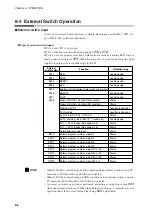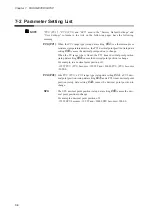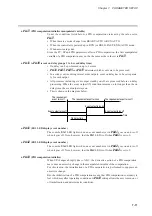
Chapter 6. OPERATION
6-5 Manual Operation and Auto-Tuning
■
Manual operation
The
↑↑
and
↓↓
keys
can be used to control instrument outputs in the MANUAL mode.
●
Controller function operations
When outputs are indicated in the basic display status, only one digit in the output value
flashes. Increasing or decreasing the output value using
↑↑
and
↓↓
keys
causes the actual
output to change accordingly. Unlike setting registration, there is no need to press the
ENTER key
.
Use the
←
←
and
→
→
keys
to move the flashing digit.
Setup data
C35
is used to select smooth and preset output changes when going from
AUTO to MANUAL modes.
Changes from MANUAL to AUTO are smooth.
(Note, however, that when the integral time setting for a PID group PID parameter of 0
may cause abrupt changes.)
●
Programmer function operations
SP can be set manually when setup data
C21
is set to 0 and programmer functions oper-
ate.
When SP is indicated in the basic display status, only one digit in the output value flash-
es. Increasing or decreasing the SP value using
↑↑
and
↓↓
keys
causes the actual SP value
to change accordingly. Unlike setting registration, there is no need to press the
ENTER
key
.
Use the
←
←
and
→
→
keys
to move the flashing digit.
Regardless of setup data
C35
setting, output changes going from AUTO to MANUAL
modes are smooth.
Changes from MANUAL to AUTO program pattern SP are used and abrupt output
changes may occur.
■
Auto-tuning (AT)
Set values can automatically be written when using auto-tuning (AT) in the RUN,
HOLD, FAST and END modes during AUTO mode operation and PID groups (1 to 9,
A1 to A7 or constant value control) are being used.
In READY AUTO mode, the tuning points of PID parameters
tP-A1
to
tP-A7
set-
tings can be used as SP to perform auto-tuning of PID groups A1 to A7 values.
Variable parameter
PA08
allows the following selections:
0 : AT is not performed.
1 : A general AT operation of a PID group used in a mode other than READY
mode
2 : AT of PID values that do not easily overshoot can be written to a PID group
used in a mode other than READY mode.
3 : A standard AT operation is repeatedly performed on PID groups A1 to A7 in
READY mode.
4 : Repeated AT of PID values that do not easily overshoot can be written to
PID groups A1 to A7 used in READY mode.
• During auto-tuning, program run time stops. Thus the RUN and FAST modes are
changed to the HOLD mode.
6-12
Содержание DCP550
Страница 1: ...EN1I 6186 Issue 13 04 08 DCP551 Mark ΙΙ Digital Control Programmer User s Manual www honeyvell energy ...
Страница 115: ...Chapter 7 PARAMETER SETUP Settings by event type For information on event operations see Events pages 5 5 to 5 15 7 13 ...
Страница 117: ...Chapter 7 PARAMETER SETUP 0 1 02 3 02 3 0 1 1 4 5 1 4 6 1 4 5 2 2 2 7 15 ...
Страница 119: ...Chapter 7 PARAMETER SETUP 0 11 2 2 3 3 7 17 ...
Страница 122: ...Chapter 7 PARAMETER SETUP d A5 tP A5 CP A5 rE A5 P A6 I A6 d A6 rE A6 CP A6 tP A6 P A7 I A7 d A7 rE A7 CP A7 tP A7 7 20 ...
Страница 209: ...Chapter 12 CALIBRATION Figure 12 11 Current Outputs 12 18 ...
Страница 229: ......
Страница 230: ...No CP UM 5024E ...
















































